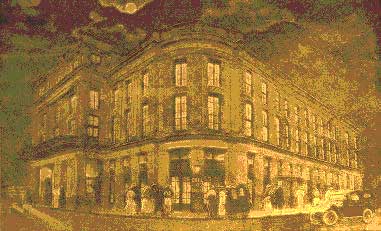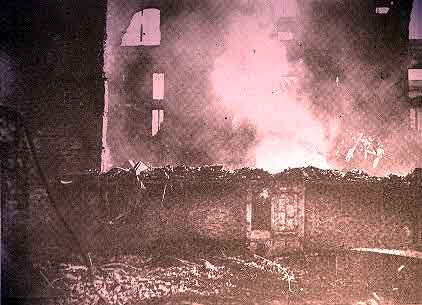The ghost of a New Orleans
notorious witch still walks the Haunted
Cities Streets. Some people claimed they
encounter this female ghosts apparition
on St. Ann Street near Bourbon each night.
No it's not the Ghost of Witch Queen Onieda
Toups, infamous Marie Laveau or the most
evil "Wicked Witch of the South",
Delphine Lalaurie. But that of a long dead
witch locals call Margurite. You may hear
of the Witch of the French Opera who lived
in a house at Bourbon and Toulouse where
the opera house once stood. Spurned by her
young lover, the old Madam committed suicide,
threatening in a final note: "I will
Come back from the dead I will return, And
kill those that have hurt me!" An many
say return she did, to kill the man and
his new love and to haunt tourists and locals
for many decades to come.
The Inn on Bourbon, on the
corner of Toulouse and Bourbon Streets,
rests on the site of the Old French Opera
House, for 60 years, the cultural center
of New Orleans Creole society, and the first
opera house in the United States.
The opera house was one of the most famous
masterpieces designed by noted architect
James Gallier, architect of Gallier Hall
and many other classic 18th Century buildings.
The great elliptical auditorium was beautifully
arranged with a color scheme of red and
white, and seated 1,800 persons in four
tiers of seats. It was Greek Revival in
design, and its colonnaded front measured
166 feet on bourbon Street and 187 feet
on Toulouse Street. Its 80 foot high loft
towered above all of the buildings of the
French Quarter. In the loges of the opera
house, there were screened boxes for pregnant
ladies, ladies in mourning, and "ladies-of-the-evening"
(elegantly dressed madams from nearby Storyville).
From 1859 until it burned
in 1919, the French Opera House was not
only the scene of hundreds of operas, but
was the hub of the dwindling Creole society,
the last refuge of the "creme-de-la-creme."

The New Orleans Old French Opera House
OPERA FROM
THE ASHES
On Dec. 4 1919 the French Opera House, which
a month before had opened its first session
since the end of World War I, was razed
by a fire of undetermined origin. Designed
by architect James Gallier, the Greek Revival-style
structure on the corner of Toulouse and
Bourbon streets opened in 1850 in a city
that had been one of the earliest homes
of grand opera in North America. After the
fire, opera in the city was largely relegated
to performances by touring companies until
the founding of the New Orleans Opera House
Association in 1943.

[WPA Photograph Collection]
One reminder of its presence
remains - an indention on Bourbon Street
leading to the entrance of the hotel. It
was here that the fancy carriages of the
Creole aristocrats parked to discharge the
elegantly dressed passengers.
Margurite the witch ghost first paraded
through various parts of the Quarter going
down Toulouse St. and the Rue Royale. To
many she was known as the "Witch of
the French Opera House Ghost" for it
was from the opera building she first emerged
from and took her first walk, over 100 years
ago.
Shocking now as then is her
wretched appearance. She has ghostly white
hair which trails and drags behind her in
the streets. A horrid face paler then death
itself. Her eyes are blood red and as huge
as saucers. With tears streaming from them.
Her shroud is nothing but a white bed sheet
draped around her.
Reportedly she was the ghost
of an aging Storyville Madam. A woman whose
younger lover had taken a mistress. The
aging Madame distraught over her lover's
betrayal, killed herself. But she later
returned as a ghost and murdered her cheating
lover and the mistress in their Bourbon
Street Mansion.
The ghost has been said to
have walked the same streets for many years
from the French Opera House to a building
on Dumaine and Royal not far from the famous
Lalaurie haunted house. This was a boarding
house where she had allegedly committed
the murders. Not only killing her lover
his Mistress but the entire occupants of
the house and the servants.
The French Opera House stood
at the corner of Bourbon and Toulouse Streets
from 1859 until it was destroyed by fire
in 1919. Designed by James Gallier, Jr.,
the hall was commissioned by Charles Boudousquie,
then the director of the opera company,
which h ad previously made its home in the
Orleans Theater. After a dispute with new
owners of the Orleans, Boudousquie determined
to build a grand new house for French opera.
The building went up in less than a year
at a cost of $118,500 and for the next sixty
years, it was the center of social activity
in New Orleans. Not only opera was held
there, but also Carnival balls, debuts,
benefits, receptions, and concerts. By 1913,
however, the house had fallen on hard times
and was forced into receivership. An a nonymous
donor (actually William Ratcliffe Irby)
purchased the building and donated it to
Tulane University, along with the wherewithal
to operate it. The building reopened, and
the future looked bright--until the building
went up in flames on the night of December
4, 1919.
The first night of the opera season is the
opening of the social season in New Orleans,
and the opera itself is the most important
feature of New Orleans social life. For
nearly a century it has held the undisputed
first place in the hearts of the people
of the delightful old French-American city,
and it grows each year in popularity and
in pride of place. It must be understood,
however, that New Orleans loves her French
opera not because of the social side of
the operatic season, but because she has
be en taught for generations to love it
for the music and for art's sake. . . .
The music and musicians are the first consideration
in this splendid old house; consequently
New Orleans knows her great composers, her
Mozart, Meyerbeer, Rossini, Verdi, in grea
t detail, and knowing them so is able to
listen and enjoy the understandingly. Another
thing which adds to New Orleans's enjoyment
of French opera, and has doubtless had much
to do with the great popularity of the institution,
is the fact that one-fourth of the population
of the city speaks French in ordinary daily
intercourse, while another two-fourths is
able to understand the language perfectly.
[Leslie's Weekly. December 11, 1902]
/www.neworleansopera.org/history
Historical Milestones of Opera
in New Orleans
by: Jack Belsom
The date of the very first
staging of opera in the Crescent City cannot
now be established and seems forever lost
to music historians. But it can safely be
stated that since 1796, in the final decade
of the Spanish colonial era, New Orleans
has had operatic performances on almost
a yearly basis. What is also significant
is that, with few exceptions, throughout
the nineteenth century the city yearly boasted
a resident company that was engaged for
its principal theatre and which could be
depended upon for performances throughout
an established operatic season.
The first staging that can
be documented was that of André Ernest
Grétry's Sylvain which was sung here
on May 22, 1796. During the first third
of the nineteenth century there was slow
yearly growth as various theatres opened
(and in some cases closed) and the repertoire
was expanded to include, besides the popular
light scores of Grétry, Etienne Mehul,
Nicolo Isouard, Nicholas Dalayrac, and François
Boieldieu, works by various Italian composers
such as Giovanni Paisiello's Il Barbiere
di Siviglia and Luigi Cherubini's Les deux
journées.
The first Théâtre
d'Orléans, which had opened in 1815,
soon fell victim to fire. It was rebuilt
and opened in 1819 under the management
of impresario John Davis who for many years
was to be a leading figure in the French
theatre in New Orleans. Within a few years
the stage was set for an ongoing theatrical
rivalry when, in 1824, James Caldwell inaugurated
his Camp Street theatre which catered more
to the tastes of the growing American population.
At the end of the 1826/1827
season, rather than disbanding until the
following autumn, Davis's troupe instead
embarked on a tour of several northeastern
cities, playing Frenchdrama and opera already
in the repertoire in New Orleans, but not
yet staged in Philadelphia and New York.
To this day, ironically, these performances,
given while on tour by the ensemble from
the Théâtre d'Orléans,
are credited as American "premieres",
while their earlier performances here during
the regular seasons are unknown. Boieldieu's
La dame blanche and Gasparo Spontini's La
Vestale are but two examples from a sizeable
list.
he rise and fall of French Opera in New
Orleans frames the Nineteenth Century, from
the first recorded performance of opera
in the city in 1796 to the tragic burning
of the French Opera House in 1919. In the
early part of the century the New Orleans
opera houses imported talented European
musicians and singers and presented some
of the finest opera in the United States.
In 1796 Grétry’s “Silvain”
was performed at the St. Peter Street Theater,
the first recorded performance of opera
in New Orleans. During the 1805-06 season
the St. Peter Street Theater presented twenty-three
performances of at least sixteen different
operas to a city with a population of only
twelve thousand people. Soon other companies
were brought to the city and a rivalry developed
between John Davis, a French-born refugee
from St. Domingue who operated the Orleans
Theater, and James Caldwell, an American
who oversaw the Camp Street Theater. Competition
between these theaters mirrored the tensions
that existed between the Anglophone and
Francophone sections of the city. Each group
prided itself on the accomplishments of
its opera troupe and boasted of the superiority
of their artists. Giacomo Meyerbeer’s
“Robert le Diable,” a perineal
favorite, first premiered in New Orleans
in 1835 at Caldwell’s Camp Street
Theater, then opened six weeks later at
Davis’s Orleans Street Theater. Critics
from the French and English language press
each claimed that their company’s
performance of “Robert Le Diable”
was far superior to the other’s. From
1827 to 1833 Davis traveled with a troupe
of fifty performers to cities on the East
Coast of the United States during the summer
off-season in New Orleans. “Le Pré
Aux Clercs” by Ferdinand Hérold
was performed in New York by this “Compagnie
Française de la Nouvelle Orleans.”
Thus Creole New Orleans was, in this respect,
an exporter of French culture to the rest
of the United States.
See: Henry A. Kmen. Music
in New Orleans: The Formative Years, 1791-1841.
(Baton Rouge: LSU Press, 1966).
From Boubron Street to Paradise
- The French Opera House and its Singers,
1859-1919
VAI AUDIO, 1 CD: cat# 1153,
$16.99
Rarest of recordings by Henri
Albers, Georges Regis, Leon Escalais, Adelina
Patti, Florencio Constantino, Lillian Nordica,
Jean Vallier, Albert Huberty, and others.
Arias and ensembles from L'Africane, Guillaume
Tell, La Juive, Mignon, Rigoletto, Lucrezia
Borgia,